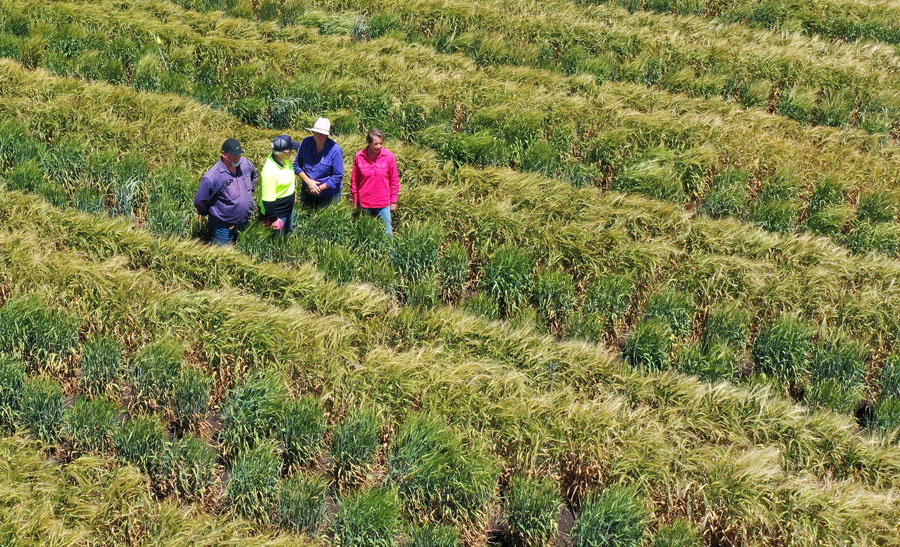Key points
- Evolving barley foliar pathogen virulence means that breeders need to stay one step ahead, incorporating new sources of resistance into varieties
- This makes it essential to keep track of changes in the pathotypes of pathogens prevalent in Australia and continue to identify new sources of resistance for breeding programs
Breeding resistance to foliar pathogens starts with identifying risky pathotypes and potential sources of resistance.
One of the most effective methods of managing foliar diseases of barley is to plant resistant varieties. However, as disease pathogens evolve there is a constant need to screen for changes in pathotype and determine whether they can overcome the resistance genes in existing varieties.
To track the virulence of major barley pathogens and identify potential sources of resistance, GRDC invested in the National Barley Foliar Pathogen Variety Improvement Program led by the Queensland Department of Agriculture and Fisheries (DAF).
Partners in the six-year program included Agriculture Victoria, the South Australian Research and Development Institute (SARDI), the Western Australian Department of Primary Industries and Regional Development, the NSW Department of Primary Industries, the universities of Adelaide, Southern Queensland and Tasmania, and the Australian National University.
Priority diseases
The diseases net form net blotch (NFNB), spot form net blotch (SFNB), spot blotch, scald and powdery mildew were identified as high priority, as most varieties lacked adequate resistance.
Each year, DAF identified pathotypes of NFNB, spot blotch and powdery mildew, collected via surveillance programs and mapped their distribution using differential sets. Differential sets are plant varieties used to define pathotypes of pathogens based on known susceptible and resistant reactions. The sets include both international and Australian host genotypes.
Researchers developed advanced methods for disease screening under epidemic field conditions and scrutinised a diverse collection of germplasm to identify sources of resistance for Australian plant breeding programs.
Lines with increased levels of resistance to multiple diseases (NFNB, spot blotch and powdery mildew) and pathotypes were identified and these traits can now be incorporated into advanced breeding lines.
For instance, there are at least 16 known major resistance genes for powdery mildew. In 2014, a new pathotype virulent on the MlLa resistance gene was identified and varieties that relied on this gene – including Commander, Mackay, Hindmarsh and La Trobe – succumbed to the disease.
Even in 2020, many of the current varieties, including Rosalind and Spartacus CL, still rely on this gene and remain vulnerable to powdery mildew. The project has identified several other resistance genes that are effective against Australian powdery mildew isolates, including Mla1, Mla7, Mla9, Mla13 and mlo, and these have now entered breeding programs.
Future planning
Fungicide resistance is another challenge highlighting the importance of breeding for alternate sources of disease resistance. Powdery mildew populations with resistance or reduced sensitivity to Group 3 fungicides have been identified in WA. Likewise, populations of NFNB have been identified with resistance to Group 7 (in SA) and Group 3 (in WA) and there is reduced sensitivity to other Group 3 fungicides (in WA).

Queensland Department of Agriculture and Fisheries staff (left to right): Pete Thompson, Janet Barsby, Judy McIlroy and Lislé Snyman in a net form net blotch disease nursery at the Hermitage Research Facility in Warwick, Queensland, in 2020. Photo: Ken Laws
Through a new three-year GRDC investment, Agriculture Victoria, DAF, SARDI and the universities of Adelaide and Queensland will continue to monitor pathogen populations to define virulency and develop suitable differential sets to monitor changes.
New genomics techniques will aid the identification of resistance genes and assist in pyramiding genes into breeding germplasm. The development of barley varieties with multiple resistances will lead to the dual economic benefit of more stable yields and improved grain quality.
More information: Lislé Snyman, 07 4542 6761, lisle.snyman@daf.qld.gov.au

























































